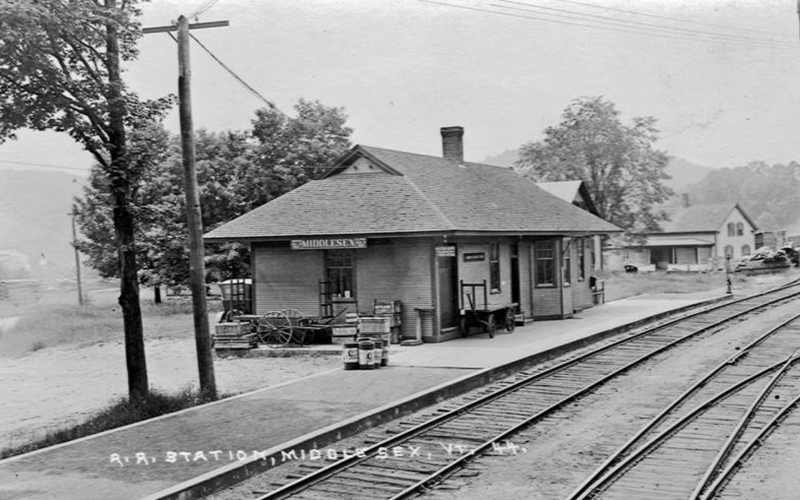Middlesex, The Valley’s neighbor to the north, is a town that has been shaped by external forces from its founding in 1793 until a few years ago. Middlesex, shaped by the Winooski and buffeted by endless floods that tore through over the years, destroying mills repeatedly, homes and businesses, was almost destroyed by the Flood of 1927.
One thing that helped the town recover from that flood was when the Vermont Central Railroad laid its tracks through the town in 1948, providing a vital lifeline not just for Middlesex, but also the towns of the Mad River Valley whose residents could access the train.
“Development of the rail transportation system in 1840s greatly boosted growth of Middlesex Village. Vermont Central Railroad completed the rail line from Windsor, Vermont, to Burlington in 1849 with an important stop in Middlesex. The tracks crossed right over the main road just below the cemetery, bisecting the village into the northern half, with activity centered around the rail station and the southern half with its stores and mills along the river. Within 20 years, this crossing had become a widened intersection and a hub of activity,” noted the authors of “Middlesex in the Making,” a 2006 history of Middlesex, written by Sarah Seidman and Patricia Wiley.
The railroad property became the heart of the village in the mid and late 1800s. A depot was built on the northside of the train tracks, directly across from the cemetery and a large freight building was constructed next to the depot which handled a lot of the freight that came through the village. That was still in use in the 1950s.
The railroad company’s original depot burned in May 1918. A new depot was built on the opposite side of the tracks. It had a ticket office and two waiting rooms and bathooms plus a freight room. This depot was used as storage shed by Sticks and Stuff in 2006 when “Middlesex in the Making” was being written.
“Residents remember that every locomotive had a different sound and many villagers learned the different whistles associated with each engine. There were as many as 12 to 14 trains a day, including two passenger trains, and each was required to blow its whistle at every crossing. There were four sets of tracks in the village two of them short spurs to get cars off the two main tracks. one spur went toward Camp Meade where Ward Lumber Company stored and handled lumber for shipping on freight cars, another went to the grain store and looped back. In the early 1900s the passenger train came through at 3:30 p.m. Village residents remember that once a year school children would take the train to Montpelier to visit the Legislature, tour the State House and the Vermont Historical Society and eat at the Imperial Restaurant on State Street. Train commerce declined as the use of automobiles and trucks increased and the Middlesex train station was closed for good in or around 1952,” Seidman and Wiley wrote in the book.
In an interview this week, Wiley said that the railroad, for Middlesex had been a real boon as it was for many small Vermont towns.
“Middlesex, when it was first founded, along with other towns intended for their town centers to be higher up, in the hills. But it became clear, as time went on and rivers were developed and roads came through, that towns and industry were going to be along the river. The railroad really added to that. The mills provided a tremendous capacity for shipping,” Wiley said.
During its heyday, Middlesex became a hub for Valley towns with Ward Lumber in Moretown relying extensively on the railroad to move lumber, Wiley said.
“By the turn of century and early 1900s you’d have had more tourism. Probably grew steadily from the time the railroad came to town until 1927. I think the Mad River Valley was probably a big draw for tourism. People got off the train and took the stagecoach down to the Waitsfield,” she said.
The combined impact of the Flood of 1927 with the closure of the rail station in 1952 led to a period of stagnation that the town is only recently shaking off with the resurgence and renaissance of the Camp Meade campus and surrounding areas, Wiley noted.
Camp Meade, constructed in 1930 by the Civilian Conservation Corporation was purchased by Planetary Matters in January 2018 and since that time, Camp Meade and the surrounding properties have become vibrant, with regular music and arts events that are free and open to the public. There have been bread festivals, several successful efforts to create the world’s largest S’More and make it into the Guinness Book of World Records.
Wiley credited Planetary Matters, and one of its principals Russ Bennett for helping change the narrative that Middlesex is a town shaped by things out of the control of the people who lived there, whether it was the contact flooding, Route 2 and later the interstate coming through, the carving off of Wrightsville and Putnamville areas of the town.
Bennett is currently lobbying hard for passenger rail service to be returned to Middlesex.
“It’s ironic, and absurd, that in the 1850s people could go anywhere in the world from the Middlesex train station. People could get to Burlington or Boston and go anywhere, north, south, east or west or across an ocean,” he said.













